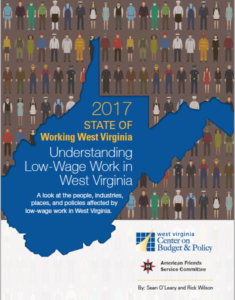 Poverty is a persistent problem in West Virginia, where tens of thousands of West Virginians live in poverty because their jobs do not pay a living wage. Read the full report.
Poverty is a persistent problem in West Virginia, where tens of thousands of West Virginians live in poverty because their jobs do not pay a living wage. Read the full report.
This 10th annual State of Working West Virginia focuses on low-wage work, including demographics of those who do the work; the industries that employ them; geographic factors; the role of public programs supporting low-wage workers; and policy recommendations to improve economic well-being.
The report reveals the shifting role of low-wage work in the state’s economy, now its main source of job growth, and a path no longer confined to young workers entering the workforce. The complete picture of West Virginia’s economy shows growth in low-wage industries, while non-low wage industries decline, and wages stagnate for both.
“Low-wage work has a profound impact on West Virginia’s economy, from the capabilities of workers to provide for their families, to their health and well-being, all the way to the sate budget,” said Sean O’Leary, Interim Executive Director for the West Virginia Center on Budget and Policy. “As low-wage jobs become more prevalent in the state’s economy, we must consider public policies that support these workers and their families, recognizing their importance to the state.”
Key Findings
- Twenty-three percent of the state’s workforce is employed in low-wage jobs.
- Forty-four percent of West Virginia’s workers with less than a high school diploma earn low wages, while the rate of low-wage workers who possess a high school degree or some college is 28 percent.
- Compared to the rest of the economy, employment in low-wage industries is growing very rapidly, by 14.5 percent since 2001. In comparison, employment in non-low wage industries declined by 2.8 percent, and overall employment has only grown by 0.1 percent.
- Overall, real average wages in West Virginia have grown by 9.7 percent since 2001, and 11.8 percent in non-low wage industries. In contrast, average wages in the state’s low-wage industries have only grown by 7.4 percent.
- More than one-quarter of workers in low-wage jobs in West Virginia (25.3 percent) live in poverty, compared to just two percent of non-low wage workers.
- Fifty-five percent of children live in a house with a low-wage worker.
- Over half – 57.6 percent – of low-wage workers in West Virginia earn at or below the minimum wage.
- A majority – 75.8 percent – of the state’s low-wage workers (123,970 workers) would benefit directly from an increase in the state’s minimum wage.
- The vast majority – 77 percent – of the state’s low-wage workers live in a county where housing is unaffordable for them.
- No longer a stepping stone, low-wage jobs are becoming lifelong employment, while industries that provide low-wage jobs have become the state’s dominant source of job growth.
- A living wage for low-wage workers would strengthen West Virginia’s economy, boost demand for goods and services provided by local businesses, and help increase the state’s chronically low workforce participation rate.
 Poverty is a persistent problem in West Virginia, where tens of thousands of West Virginians live in poverty because their jobs do not pay a living wage. Read the full report.
Poverty is a persistent problem in West Virginia, where tens of thousands of West Virginians live in poverty because their jobs do not pay a living wage. Read the full report.